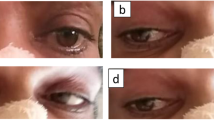Abstract
Background
Unilateral anterior spinal artery (ASA) occlusion resulting in bilateral medullary pyramidal (BMP) infarction is a rare and devastating stroke subtype. We present two cases highlighting the diagnostic and clinical challenges of BMP infarction.
Methods
Case reports and literature review.
Results
A 57-year-old man rapidly had severe vomiting and diarrhea 2 h after a meal. Examination revealed bulbar weakness and areflexic tetraplegia. Respiratory failure developed, requiring intubation and mechanical ventilation. Brain magnetic resonance imaging (MRI) showed a heart-shaped region of diffusion abnormality, characteristic of BMP infarction. Cerebral angiography showed an occluded left vertebral artery with unilateral left-sided origin of ASA. The patient required tracheostomy and percutaneous gastrostomy tube and was discharged to rehabilitation, with little improvement of his tetraplegia at 3-month follow-up.
A 43-year-old woman presented to the emergency department with acute onset of lower-extremity paresthesia and history of upper respiratory infection 2 weeks prior. Initial examination findings included bulbar weakness, dysphagia, hyporeflexia, and generalized weakness. After admission, she had severe respiratory distress and required intubation. Lumbar puncture was evaluated for Guillain–Barré syndrome, but cerebrospinal fluid protein concentration was normal. Changes on diffusion-weighted MRI of the brain showed the characteristic heart-shaped BMP infarction, indicating occlusion of a unilateral ASA. She required tracheostomy and percutaneous gastrostomy tube placement, with no paralysis resolution.
Conclusion
Acute BMP infarction may present with flaccid tetraplegia mimicking neuromuscular disorders. When the infarction is recognized early, intravenous thrombolysis can be considered to reduce morbidity of this rare stroke subtype.




Similar content being viewed by others
Abbreviations
- ANA:
-
Antinuclear antibody
- APL:
-
Antiphospholipid
- ASA:
-
Anterior spinal artery
- BMP:
-
Bilateral medullary pyramidal
- DWI:
-
Diffusion-weighted magnetic resonance imaging
- GBS:
-
Guillain–Barré syndrome
- MRA:
-
Magnetic resonance angiography
- MRI:
-
Magnetic resonance imaging
- PEG:
-
Percutaneous gastrostomy
References
Pongmoragot J, Parthasarathy S, Selchen D, Saposnik G. Bilateral medial medullary infarction: a systematic review. J Stroke Cerebrovasc Dis. 2013;22(6):775–80.
Kumral E, Afsar N, Kirbas D, Balkir K, Ozdemirkiran T. Spectrum of medial medullary infarction: clinical and magnetic resonance imaging findings. J Neurol. 2002;249(1):85–93.
Tokuoka K, Yuasa N, Ishikawa T, Takahashi M, Mandokoro H, Kitagawa Y, et al. A case of bilateral medial medullary infarction presenting with “heart appearance” sign. Tokai J Exp Clin Med. 2007;32(3):99–102.
Milandre L, Martini P, Bourrin JC, Vincentelli F, Khalil R. Unilateral infarction of the cervical spinal cord. 2 cases identified by MRI. Rev Neurol (Paris). 1993;149(4):299–302 (French).
Yuki N, Hartung HP. Guillain–Barré syndrome. N Engl J Med. 2012;366(24):2294–304. Erratum in: N Engl J Med. 2012;367(17):1673.
Brannagan TH 3rd, Zhou Y. HIV-associated Guillain–Barré syndrome. J Neurol Sci. 2003;208(1–2):39–42.
Tam CC, O’Brien SJ, Petersen I, Islam A, Hayward A, Rodrigues LC. Guillain–Barré syndrome and preceding infection with campylobacter, influenza and Epstein–Barr virus in the general practice research database. PLoS ONE. 2007;2(4):e344.
Yiannakopoulou E. Serious and long-term adverse events associated with the therapeutic and cosmetic use of botulinum toxin. Pharmacology. 2015;95(1–2):65–9.
Diaz-Manera J, Rojas Garcia R, Illa I. Treatment strategies for myasthenia gravis: an update. Expert Opin Pharmacother. 2012;13(13):1873–83.
Schaumburg HH, Herskovitz S. The weak child: a cautionary tale. N Engl J Med. 2000;342(2):127–9.
Ma L, Deng Y, Wang J, Du F, Xia F, Liu Y, et al. Bilateral medial medullary infarction presenting as Guillain–Barré-like syndrome. Clin Neurol Neurosurg. 2011;113(7):589–91.
Cosi V, Versino M. Guillain–Barré syndrome. Neurol Sci. 2006;27(Suppl 1):S47–51.
Roh JK, Lee YS. Bilateral medial medullary infarction manifested as sensory ataxia: a case report and review of the literature. J Korean Med Sci. 1996;11(2):193–6.
Santos-Franco JA, de Oliveira E, Mercado R, Ortiz-Velazquez RI, Revuelta-Gutierrez R, Gomez-Llata S. Microsurgical considerations of the anterior spinal and the anterior-ventral spinal arteries. Acta Neurochir (Wien). 2006;148(3):329–38.
Gofton TE, Barber PA. Anterior spinal artery infarction at the cervicomedullary junction. Can J Neurol Sci. 2006;33(4):418–20.
Machnowska M, Moien-Afshari F, Voll C, Wiebe S. Partial anterior cervical cord infarction following vertebral artery dissection. Can J Neurol Sci. 2008;35(5):674–7.
Hundsberger T, Thomke F, Hopf HC, Fitzek C. Symmetrical infarction of the cervical spinal cord due to spontaneous bilateral vertebral artery dissection. Stroke. 1998;29(8):1742.
Andreoli L, Chighizola CB, Banzato A, Pons-Estel GJ, Ramire de Jesus G, Erkan D. Estimated frequency of antiphospholipid antibodies in patients with pregnancy morbidity, stroke, myocardial infarction, and deep vein thrombosis: a critical review of the literature. Arthritis Care Res (Hoboken). 2013;65(11):1869–73.
Author information
Authors and Affiliations
Corresponding author
Ethics declarations
Conflict of interest
The authors declare that they have no conflicts of interest.
Rights and permissions
About this article
Cite this article
Searcy, S., Akinduro, O.O., Spector, A. et al. Heart-Shaped Bilateral Medullary Pyramidal Infarction as a Pathognomonic Finding of Anterior Spinal Artery Occlusion. Neurocrit Care 28, 388–394 (2018). https://doi.org/10.1007/s12028-017-0406-7
Published:
Issue Date:
DOI: https://doi.org/10.1007/s12028-017-0406-7




